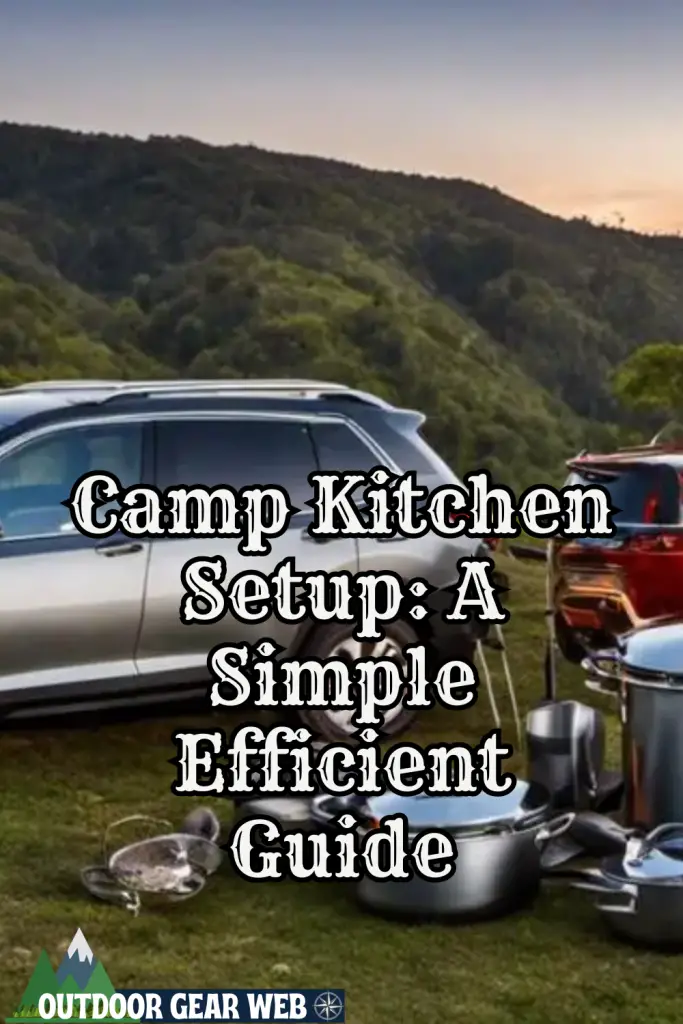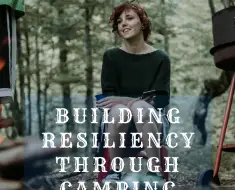
Heading out into the beauty of nature is a breathtaking escapade with camping being a quintessential part of the experience. Yet, the delight of the outdoors can be significantly magnified by the appetizing aroma of a vibrant camp kitchen. Whether you’re a seasoned camper or a novice prepping for your first adventure, understanding how to set up an efficient and safe camp kitchen can ensure that your outdoor experience is as enriched and satisfying as it can possibly be. This write-up will guide you through choosing camping cookware that is durable, efficient, and portable for an outdoor environment. It will also provide insights on organizing your camp kitchen, tips on food storage and waste management, and introduce you to various cooking methods and easy recipes adaptable in the wilderness. Having the right camp kitchen setup will make your meal time easy and enjoyable.
Read more about Car Camping Kitchens – Everything You Need
Camp Kitchen Setup: Choosing the Right Camping Cookware
Exploring Camping Kitchen Items
When setting up a camping kitchen, it is important to explore different types of equipment. Cooking while camping may entail preparing a variety of meals, and therefore a selection of pots and pans are essential. Consider options such as a compact camping cook set, which often includes a pan, pot, and even a kettle. This design ensures that all items nestle into one another, making a compact and easy-to-pack item.
Additionally, no kitchen is complete without utensils. When camping, opt for utensils that are specifically made for the outdoor experience. These usually come in a compact set that includes a knife, fork, spoon, and even a pair of chopsticks. For added convenience, you may wish to choose a ‘spork’, which is a fork and spoon combined into one efficient utensil.
Choosing a Camping Stove
Camping stoves are also a fundamental part of a camp kitchen. When choosing one, consider factors like the number of people you will be cooking for, your favorite camping recipes, and how much space and weight you can afford to dedicate to a camping stove in your pack. Camping stoves come in a variety of styles, including classic two-burner propane stoves, backpacking stoves that run on isobutane-propane fuel canisters, and even wood-burning stoves.
Value of Durability, Efficiency, and Portability
While functionality is key, it’s just as crucial to choose items based on their durability, efficiency, and portability. As camping gear is frequently exposed to rough outdoor conditions, it should be hardy enough to withstand these. Stainless steel pots, pans, and utensils are often a good choice due to their durability.
Efficiency is another aspect to consider. Camping kitchen items should work effectively to ensure cooking is a smooth and enjoyable process. For example, a well-insulated pot will not only cook food evenly, but also conserve fuel.
Don’t overlook the importance of durability, especially for camping. Items should ideally be lightweight and easy to carry around. Many camping kitchen utensils collapse or fold up to save space. For instance, there are pot sets that stack together, or stoves that fold up into a compact case.
Lightweight and Compact Cookware
With packing space often at a premium when camping, it becomes vital to choose lightweight and compact cookware. This is especially true in the case of backpacking trips where every ounce counts. Cookware that is bulky or heavy may be more trouble than it’s worth. Thankfully, there are many options available on the market that are light, compact, and travel-friendly. These include foldable stoves, collapsible pots and bowls, and even utensils that can be disassembled for easy storage.
Camp Kitchen Setup Gear
Don’t make setting up your camp kitchen complicated. By taking the time to explore different items, considering your needs, and opting for durable, efficient, and portable cookware, you will be well on your way to creating a functional and comfortable outdoor kitchen.

Camp Cooking Hacks – 15 Tips and Tricks to Make Camp Cooking Easier.
Camp Kitchen Setup: Organization and Layout
Planning your Camp Kitchen Layout
Proper layout and organization of your camp kitchen is crucial for both safety and efficiency. The first step involves identifying three separate areas for your kitchen: food preparation, cooking, and washing. Having distinct zones for these tasks helps maintain cleanliness and minimizes cross-contamination, an essential factor for outdoor food safety.
Selecting the Food Preparation Area
The food preparation area should be clean and flat, with enough room to chop, slice, and prepare your meals. Cover your kitchen, if possible, to keep your food safe from weather elements. Always ensure the food is in airtight containers and that you thoroughly clean all utensils and preparation surfaces before and after use.
Choosing a Cooking Spot
Select your camp cooking area with the utmost caution, considering it involves fire. Choose a place that’s well-ventilated, away from trees, bushes, and your tent to avoid fire accidents. The area should also be flat to provide stability for your cooking equipment. The cooking spot must be a safe distance from your sleeping tents, which helps deter wildlife attracted by the smell of food, ensuring safety for campers. As an added precaution, always ensure you have a fire extinguisher or ample water nearby in case of a fire outbreak.
Identifying a Washing Station
Your washing station should be away from both the cooking and preparation areas to prevent soap or residue from contaminating the food. The washing area should ideally be downhill and at least 200 feet away from water sources to avoid contaminating these sources with grey-water.

Keeping a Clean Camp Kitchen
After each meal, ensure to clean up your camp kitchen. Promptly deal with spills and trash. Trash should be stored in a lockable container and disposed of at designated spots or packed out.
Your ability to efficiently set up and maintain a camp kitchen will have a significant impact on your camping experience. It ensures you can prepare meals more comfortably, keeps your camping area clean, and, most importantly, maintains the safety of your camping experience.
Food Storage Tips
Food and ingredients should be stored in airtight containers to keep them fresh and deter pests. Keep your food organized by meal and day to keep track of what you have and minimize the amount of time spent searching for ingredients.
Learn these Backpacking and Camping Food Storage tips.
Camp Kitchen Setup: Food Storage and Management
Proper Food Storage Techniques
Safeguarding your food while camping is crucial not just to prevent spoiling, but also to avoid attracting wildlife inhabitants. The primary methods include cooler use, hanging bags, and using bear-proof containers.
A cooler is essential for any perishable goods. To keep your food colder for longer periods, fill the cooler with block ice rather than cubes and place your perishable foodstuffs on top. To keep things clean and dry, store food in water-tight containers or ziplock bags before placing them in the cooler.
Bag hanging is another effective method, especially in wilder environments where bears or other large wildlife might be around. The PCT Method is popular – hang the bag at least 10-12 feet high and 6 feet from any vertical supports (trees or poles).
However, in certain bear-heavy locations, bear-proof containers are mandatory. They are hard plastic containers with secure lids that are nearly impossible for most wildlife to get into. Place your food inside and store it at a distance away from your campsite to discourage curious critters.
Eco-Friendly Waste Management
Managing waste while camping should always be done with minimal environmental impact in mind. All waste materials should be packed out to maintain the integrity of the outdoor spaces we enjoy. This includes organic waste like fruit peelings, as they can negatively impact local fauna.
One rule of thumb is the ‘Leave No Trace‘ principle, which means if you bring it in, you take it out. Use resealable bags or containers to collect your trash and take it away with you.
For dishwater, use biodegradable soap and dispose of the water at least 200 feet from any water source to avoid contamination. Similarly, for human waste, either pack it out using waste bags or dig cat holes 200 feet from water sources, trails, and camp.
Remain conscious of your camp kitchen’s impact on the surrounding environment. Ensuring proper food storage and waste handling will not only keep your food safe and environment clean, but it also respects and protects local wildlife.
Become an Expert at Campfire Cooking
Camp Kitchen Setup: Cooking Methods & Easy Recipes
Understanding Various Camping Cooking Methods
When setting up a camp kitchen, one of the first things you need to consider is your main cooking method. There are a variety of cooking methods you can use at the campsite, each with their own pros, cons, and setup requirements.
Open-fire cooking, for example, is probably the most traditional way of cooking at the camp. You can cook directly on the coals, or on a metal grill that you set over the fire. You’ll need a supply of dry wood for fuel, and matches or a lighter to start your fire. Before you set up your fire, check the local regulations and safety recommendations, as open fires may be prohibited in certain areas due to the risk of wildfires.

Propane stove cooking is another popular camping cooking method. This involves using a portable propane stove, which can be easily transported and set up. Propane stoves provide a controlled heat source, which can make them easier to cook on than an open fire. You will need a propane fuel canister to power your stove, which should be checked regularly to ensure it has enough fuel.
For those who enjoy baking, using a camping oven can be ideal. These are typically fueled by propane and are able to reach and maintain high temperatures, similar to your oven at home. You need a flat, stable surface to set your camping oven on, which can be a challenge in some campsite situations.
Exploring Easy to Make Camping Recipes
Once you’ve decided on your cooking method, the next step is to plan out your meals. There are countless easy-to-make and nutritious camping recipes out there, many of which require minimal ingredients and cookware.
For breakfast, consider making something simple like oatmeal or scrambled eggs. Both of these dishes can be easily made on a propane stove or an open fire and require only basic ingredients. For lunch, you could make a simple tin foil meal, which is essentially meats and vegetables seasoned, wrapped in aluminum foil, and cooked directly on the fire or on your camping stove. For dinner, try making a camping stew. You can prepare the ingredients ahead of time, bring them in a cooler, and cook everything in one pot over your fire or stove.
Make sure your recipes don’t involve a lot of perishable ingredients that could potentially spoil, unless you have a cooler or fridge to store them in. Keep things simple, use sturdy and lightweight cookware, and make sure you bring along enough water for both cooking and cleaning up afterward.
Final Thoughts on Camp Kitchen Setup: A Simple Efficient Guide
By understanding your cooking method and planning your meals in advance, setting up a camp kitchen can be both a fun and rewarding experience. There’s no doubt that a well-organized and efficiently-managed camp kitchen can enhance your camping experience. With the right cookware, a thought-out layout, smart food storage, and a repertoire of easy recipes, you will not only ensure a seamless cooking process but also introduce an element of fun and adventure to your meals. Finally, remember, part of the joy of camping comes from respecting the environment. Therefore, always ensure that your kitchen setup, waste management, and food storage principles align with eco-friendly practices. Here’s to more hearty meals amid serene landscapes and under starlit skies; may your camping experience be truly enriching.

















